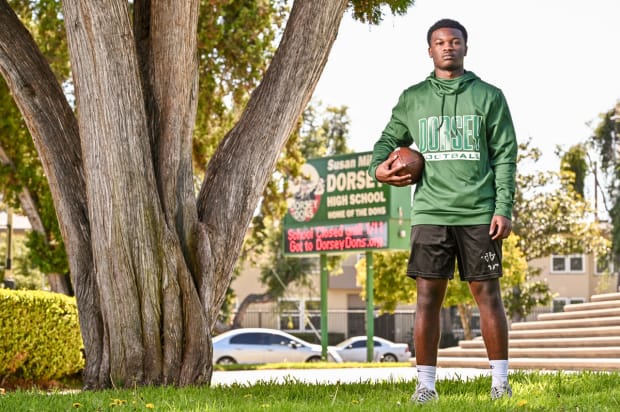One SoCal conference used to firehose the pros with future all-stars, from Don Drysdale to Keyshawn Johnson. Today, a fight for survival
A century ago, below the green hills where the first talking movies were being made, the city of Los Angeles built a series of public high schools to accommodate its rapidly growing population. Most were named after presidents or founding fathers—Franklin, Jefferson and Roosevelt high schools sprang up between 1916 and ’25—and today they still stand as architectural marvels, even if their exteriors show a few cracks.
In 1935 these tight-knit secondary schools formed a sports league they called the City Section. Together, over the remainder of the American Century, they produced a parade of future professional Hall of Fame athletes, including Bob Waterfield (Van Nuys High, Class of ’38), Hugh McElhenny (Washington, ’48), Don Drysdale (Van Nuys, ’54) and Gail Goodrich (Polytechnic, ’61), not to mention champion swimmer and film star Esther Williams (Washington, ’39). But the league’s true golden era came when the color of its athletes started to change, when players like Ozzie Smith (Locke, ’73), Marques Johnson (Crenshaw, ’73) and Warren Moon (Hamilton, ’74) filled antiquated gyms and stadiums, inspiring sports-mad Angelenos to skip Lakers and Dodgers games and cheer on their neighborhood teams in a purer form of competition.
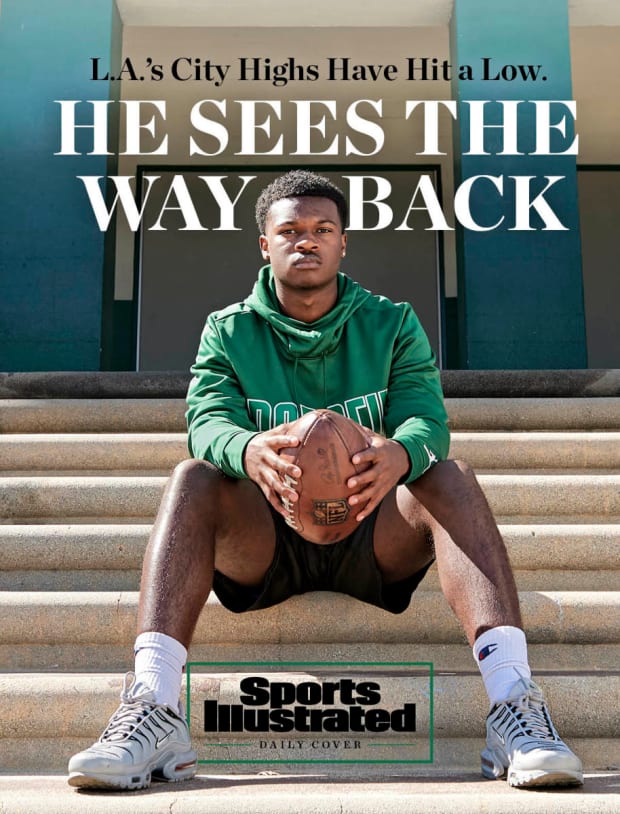
That heyday lasted through the turn of the millennium. “The City Section was a powerhouse in every sport, especially football,” says Johnathan Franklin, an all-City Section running back during the late 2000s at Dorsey High, who went on to become UCLA’s all-time leading rusher and who today works in the Rams’ front office. “It was the most important thing in L.A. from September to December. Every kid wanted to go to a City school. The streets were flooded with recruiters from across the country. As a middle school student watching the Dorsey-Crenshaw rivalry, Fremont [vs.] Banning, those players were our idols.”
Franklin became one of those teenage heroes. “Clerks and community members in the grocery store would tell you, Good luck, Friday, Johnathan! Young kids playing in the street [would say], Oh man, he plays for Dorsey! At age 16, 17, we were role models, when there wasn’t a lot of positivity going on. ... High school sports was an opportunity for everyone—for those in the streets, for those who had great jobs—to come together and celebrate something that the community created, and needed.”
Then, quicker than a footrace between Florence Griffith-Joyner (Jordan, ’78) and Valerie Brisco-Hooks (Locke, ’78), it ended. Today’s rosters are thinner in every sport across the City Section’s oldest member schools, whose culture and community enthusiasm stand diminished as well. Who knew that when De’Anthony Thomas (Crenshaw, ’11) was criss-crossing urban football fields 10 years ago, before starring at Oregon and matriculating to the NFL, the denouement had already arrived? Crenshaw’s enrollment in that 2011 season was 1,466 (half of what it had been a decade earlier). Its football roster was 70 kids strong. By 2019 those numbers were 678 and 25.
Two telling football games were played in that 2019 season, the last year before the pandemic. In August, Crenshaw High lost 48–0 to Upland, located 40 miles east of L.A. in the Inland Empire, where countless African American families had moved over the preceding decades due to overcrowding or concerns about crime and the cost of living in the city. “We built new [city] schools under the premise that we were overpopulated,” says 68-year-old Paul Knox, the former Dorsey coach who in his 27 years leading the Dons won four City Section championships and oversaw dozens of future pros. “But by the time we got them built, people had moved to the outlying areas. So, today we have a lot of schools, but not a lot of kids.”
And in October ’19, Crenshaw bounced back to crush longtime rival Dorsey, 51–0. Dorsey had just 20 players. Back in the era of future NFL first-round picks Chris Mims (’89) and Keyshawn Johnson (’92), Dorsey dressed 80 kids on Friday nights. (“I had teams with three Division I tailbacks,” Knox recalls.) Longtime Crenshaw coach Robert Garrett wasn’t gloating when he said after that ’19 blowout: “I’ve never seen Dorsey so down in all my days.”
He could have been speaking about the whole league. Fremont High, built in the heart of South L.A. in 1923, had an enrollment of 5,000-plus students by the mid-2000s. That number was 2,125 last year. Nineteen Fremont players have gone on to play in the NFL but only two in the last three decades.
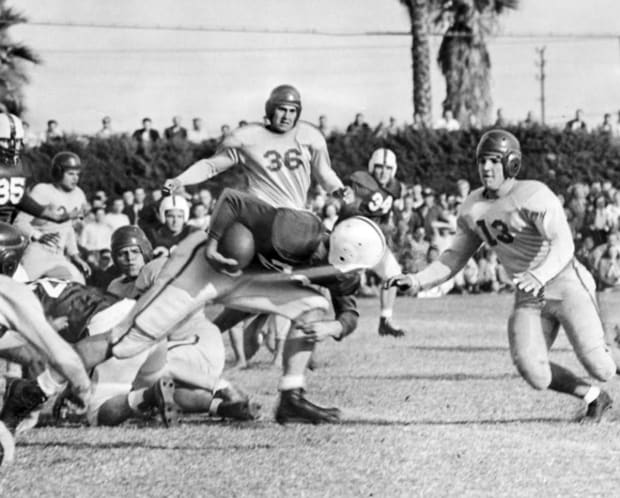
Beyond the inner-city flight, decades of state and federal cuts to public education, which trickle down to athletics, haven’t helped. Neither have the hundreds of charter schools that have popped up on City Section turf over the last 30 years, draining enrollment and decimating sports teams’ depth. But nearly everyone agrees that the main reason for the demise of City Section athletics has been the aggressive recruiting of area private schools, some of which are down the street but most of which lie in the suburbs. “They come and recruit the best kids out of your area, promising them exposure and [college] scholarships,” says Knox, who still coaches in the City Section, at Washington. “That’s what has left the biggest hole.”
If future Pro Football Hall of Famers John Elway or James Lofton had come of age in today’s SoCal sports landscape, instead of in the 1970s, odds are they wouldn’t have graduated from City Section stalwarts Granada Hills (Elway) and Washington (Lofton). They’d be invited to attend the private-school powers that have spread across the region over the years. Or their parents might shoot the works and send them to IMG Academy in Florida, which doesn’t hide the fact that it puts sports first and has spawned a number of similar athlete-factories nationwide.
The public-versus-private school tug of war isn’t just happening in L.A., after all. And it’s not just football, either. Exclusive institutions like Mater Dei (in Orange County) and St. John Bosco (in Bellflower) appear atop the national rankings in basketball every year. Their players pepper the top college rosters the way that Dorsey’s and Crenshaw’s used to. Sierra Canyon’s dominant program (in Chatsworth), featuring Bronny James, is the subject of an upcoming Amazon docuseries.
In 2010 the Los Angeles Times’ final top-25 basketball rankings included 19 public high schools.
In 2020 only eight made the list.
Andy Moran, the football coach at Eagle Rock High and the chairman of the City Section’s coaches advisory committee, sat in his tiny office last spring telling a too-familiar story about a recent Thursday night he spent at a City Section game, scouting a team on his schedule. “A few Dorsey players stopped by when their practice ended,” Moran recalled. “By the second quarter, the bleachers were filled with local kids wearing jackets from [private-school powers] Alemany, Oaks Christian, Mater Dei, Cathedral. … You realized that all these kids would probably be going to Dorsey if they hadn’t been steered toward private schools.”
This inverted gentrification of high school sports in L.A. is a tricky issue to address. What parent can turn down a financial aid package that would send her kid to private school?
In football, Moran says, the difficulty “starts with street agents,” referring to the stealth power brokers who operate within local seven-on-seven passing leagues each offseason. “There’s something about being recruited [to play seven-on-seven]. It’s exciting for kids to be invited to join one of these teams,” the best of which are informally linked to powerful high school football programs. The lure has proved hard for families to resist.
“It can be exhausting trying to get your kids not to leave,” Moran adds. “It’s like AAU basketball: If you don’t get them on the right passing league team, [with] someone who’s not gonna try to take them from you, they’re gone.”
This machine fascinates 17-year-old quarterback Josh Coleman. “I feel like a lot of parents have instilled in their kids that you have to go to Mater Dei, to Bosco, to be a three-star or four-star recruit,” he says. But he sees a simpler way. “I want to prove that you can do it at your local school, right down the street.”
Josh, who in early 2020 transferred to Dorsey from St. Bernard, a tony private school along the Pacific, comes from a long line of radical thinkers. In the 1870s the United States’ first Black senator, Hiram Rhodes Revels, mentored Josh’s great-great-grandfather, John Meekins, at Alcorn A&M (now Alcorn State). Meekins’s son, Thomas B. Coleman (Josh’s great-granddad), was one of the first Black dentists in Mississippi. His son ventured west, attending Benedictine College in Nebraska before heading to L.A. to become a policeman.
The son of that cop is Josh’s dad, John Coleman, a healthcare tech professional who these days works from his modest Inglewood duplex. John grew up in the heart of the City Section. He “got out,” he says, by way of a baseball scholarship to the same private school in Playa Del Rey that Josh just left. Attending St. Bernard “changed my life,” John says, describing his journey to a Duke MBA and his marriage to Chauntee, holder of two USC graduate degrees. Their oldest child went to St. Bernard, too, and today attends the Morehouse School of Medicine.

That was Josh’s path—four years at St. Bernard, then college—until he raised eyebrows by transferring to Dorsey and its gutted football program.
Inside the Coleman home, a big-screen TV is tuned to CNN, the volume muted. Images of the previous day’s attack on the U.S. Capitol flash across the living room. “Just because it’s a private school doesn’t mean that it has the best education for you,” Josh explains, dressed in black sweats, a black medical mask under his chin. “You have to go somewhere that fits you, that benefits you and your community.”
He had other reasons for transferring. St. Bernard had just hired a coach who in his previous job won multiple City Section titles but left amidst an inquiry into academic misconduct that occurred on his watch. That coach (who denied any wrongdoing and was cleared by an investigation) brought several highly recruited quarterbacks with him to St. Bernard, including a freshman who was talented enough to have already received several offers from Power 5 colleges, and a senior transfer who was coming off a City Section title.
Josh, who threw an impressive-but-not-mindblowing 23 touchdown passes across his freshman and sophomore seasons, was facing a junior year, the most critical for any aspiring college player, on the bench.
High school football, says Josh’s dad, “has become a business. I had to help Josh understand that those things happen in life. … You have to recoup and move forward.”
Josh heard from other private schools that wanted him, but he was drawn to the idea of defying the trend epitomized by Oregon defensive end Kayvon Thibodeaux, who played at Dorsey High as a freshman and sophomore, then transferred to Oaks Christian School, a private academy situated on 25 tree-lined acres northwest of the city, before signing with the Ducks and establishing himself over the last two years as an early-round NFL prospect.
Could Thibodeaux have reached the same heights by staying at Dorsey? If Alabama freshman Bryce Young had played at a City school instead of Mater Dei, would he still be Nick Saban’s QB-in-waiting right now? Would D.J. Uiagalelei be Trevor Lawrence’s successor at Clemson if he had gone to a public school instead of Bosco?
Do private schools educate elite athletes or promise them platforms? Are they institutions of learning, or are they brands with which teenage athletes partner?
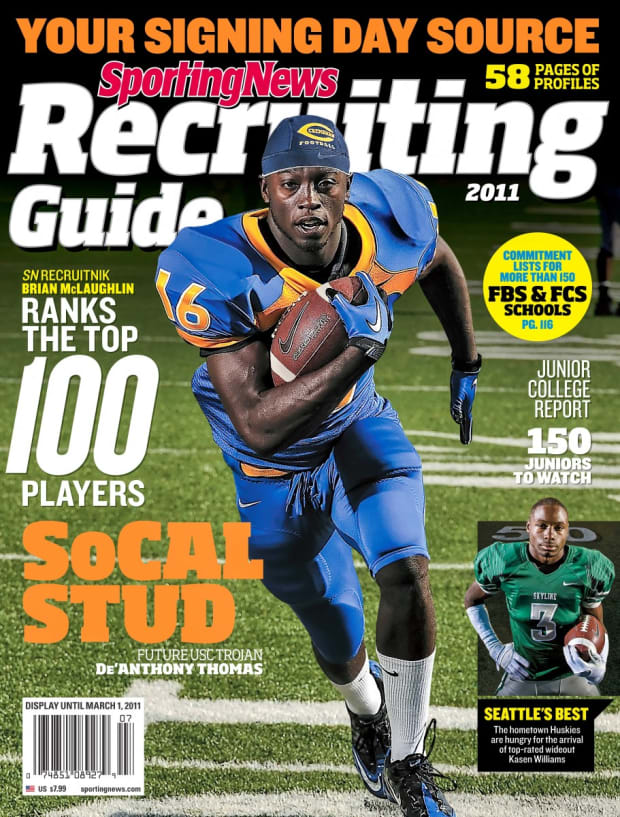
“They sell a dream,” says Josh, who has seen dozens of friends and teammates leave public schools and accept athletic aid to attend private institutions. “They scoop all the kids up and promise exposure and college scholarships and other things. Families get distracted and decide that’s the way to go.”
It’s not illegal. It’s not even shady, stresses Moran, the Eagle Rock coach, as long as the kid benefits from the arrangement. But circumstances can change. Coaches come and go. “I’ve seen kids get squeezed out [of private schools], their school money taken away, their tuition raised so they can’t afford it. I don’t see how that’s helping someone. That’s just using kids.”
That’s not what happened to Josh, but it occurs often enough for City Section commissioner Vicky Lagos to realize: “It’s an issue. I’m not sure [parents] know what they’re getting into sometimes. … I wonder if some kids regret not going to their local school. I’m sure a lot of them are being promised things they don’t get.”
Josh’s new coach at Dorsey High could have chosen a cushier path. Stafon Johnson, 33, graduated from Dorsey as the City Section’s all-time leading rusher, then starred at USC under Pete Carroll. He could have continued coaching junior college ball until he caught on as a high-earning D-I assistant and recruiter. “But it was my calling,” he says, “to return to Dorsey and bring my networking and all the things I’ve learned during my journey—to bring it back to the ’hood.”
Johnson arrived in December of 2019 to find just 19 kids on varsity. One of the first calls he received was from the Colemans, who were seeking a place for Josh to land. The new coach didn’t try to sell them. “Dorsey is home for me, so I just sent them to my aunt, our magnet coordinator.” A so-called magnet program, designed for advanced students with a college-preparatory curriculum, “was something that they—like other families—didn’t even know we had here.” That it was administered by the football coach’s aunt (a Ph.D. holder herself) only added to Dorsey’s family appeal.
Sold on Dorsey, Josh spent one month at the school—“one of the best months of my life,” he says—learning about the actors, artists and activists among Dorsey’s alumni, and participating in offseason workouts. He found his coursework to be as intellectually challenging as it had been at St. Bernard. He was just getting to know his new teammates when—bam—COVID-19 sent everyone home to “Zoom school” for the rest of 2020. Everyone with a laptop and Wi-Fi, anyway.
“At Dorsey there are a lot of kids with different lifestyles and different backgrounds,” Josh says. “For some of them, sports is their energizer. Football is what helped them go to class or do that assignment.” Instead, those students watched impatiently as high schools in Texas and Florida kicked off in August, playing full seasons, while they stayed home.
In December, Josh and another City Section quarterback, senior Dylan Kordic, wrote to Lagos, the league commissioner; and Austin Beutner, superintendent of the Los Angeles Unified School District:
… While we recognize that the Corona Virus is potentially life threatening and serious, we have not been privy to any discussion about the return to school or athletics. … This disconnect has led to student-athletes becoming depressed, and disappointed.
The letter led to a barrage of supportive texts and DMs from City Section kids and their parents (Football is the only thing I have … I wish I was at practice rn … I need to get away from the house. Lot of stuff going on), and to a Zoom call with Lagos, herself a former coach, who assured the players she was on their side. “I think it showed a high level of maturity,” Lagos says of the teenagers’ reaching out and speaking up for their classmates. “These are our future leaders.”
Coach Johnson, meanwhile, was wrapping up a strong year of recruiting, without any financial enticements. Now, he says, “I have roughly 65 kids in our [football] program”—kids who weren’t lured by form-fitting, photogenic uniforms, like the kind private schools receive every year but by “the opportunity to build something.”
“There is a trust in Stafon from the community,” says Franklin, the former Dorsey star who today works as the Rams’ director of social justice and football development. “We used to say, ‘DDP For Life.’ Dorsey Dons Posse. It was this unique culture of family, of grit, of, We’re doing everything we can to win, while also caring for each other. That DDP culture was thriving at [the City Section’s] peak. Stafon has a tremendous opportunity to turn this program around.”
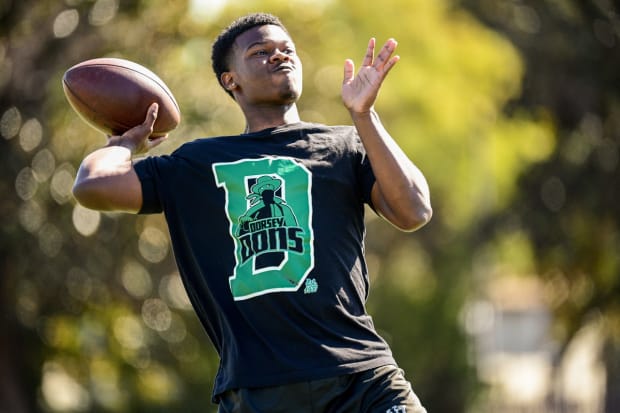
Josh Coleman, Johnson says, “ is the focal point of what I’m trying to build. ... An atmosphere where student-athletes have all the resources they need. Tutoring, top-of-the-line weight room, structure. Former [Dorsey] players with college degrees, coming back to mentor them. A program, not just a football team.
“I want to bring all my babies home; that’s my motto,” he says, the fatigue of a long 2020 evident in his voice. “Let them know they can get the same opportunities right here, off of Obama Boulevard, that they can get at any other campus.”
Josh is assessing his college options with the same approach. A 4.0 student, he feels equally drawn to historically Black colleges and universities as he does to the Ivy League schools that have shown interest. “With what’s going on in the world,” he says, “it’s great seeing four- and five-star [recruits] having HBCUs in their top five.”
The best leaders, he says, “move different.” Instead of blowing the money he’s earned from his self-made clothing line, Cohesive, he’s poured it into a podcast showcasing other high school players, mostly quarterbacks, that he deems to be underrecruited. He layers the conversations with music and video highlights, using his mom’s computer.
Last Christmas, Josh got a set of weights. He works out in his garage before Zoom school and afterward spends an hour or two at Fox Hills Park, setting his cleats in the overgrown grass and firing spirals to his friend, Elijah Washington, a 6' 4" receiver who used to play at St. Bernard but who’s now in the City Section, too, at Westchester High. Josh’s dad fears that if these kids don’t play some sort of real football this spring—even if it’s just four or five games—“high school football in the city will be over. Kids will drift away from it.”
His hopes, and those of countless other parents in the city, were realized last week when local authorities granted City Section schools permission to resume football activities, along with other contact sports, and play an abbreviated season before summer break. Josh’s phone buzzed nonstop when the good news arrived, as friends from across the private- and public-school spectrum shared their excitement with their de facto leader. “It’s just a blessing,” Josh says.
But the private-school recruiting issue, which, like the pandemic, is intertwined with classism and a wealth gap between Black and brown and white, remains. “I don’t know if there is a fix,” says Knox, the coach who guided Dorsey during its peak. “I don’t know how you keep [private schools] off of you. What can you tell parents when they tell you they can get a better education for their child, and have it paid for? I don’t know how you match that.”
The only answers Knox can see live within young leaders like Josh Coleman, who believes in what’s possible in the community. And within one of Knox’s former players, who today sits in his old office. “I’m really hoping Stafon can get guys to come back and turn it around,” the old coach says. “It takes young guys like him to change things for the better in the City Section.”
In the interim Coleman is calling off the practices he scheduled for his seven-on-seven team—a team he built himself in an effort to provide game tape to college recruiters this spring. No need for that anymore. Soon he’ll put on a kelly green Dorsey helmet for the first time.
“I can already see that first game,” he says, grinning. “If they allow people in the stands, it will be crazy. I know all the alumni will be out. It will be a big night for Dorsey. For the whole city.”
A weakened but still-proud culture will be watching, fingers crossed.
